height VOLVO C30 2013 Owner´s Manual
[x] Cancel search | Manufacturer: VOLVO, Model Year: 2013, Model line: C30, Model: VOLVO C30 2013Pages: 300, PDF Size: 6.58 MB
Page 22 of 300
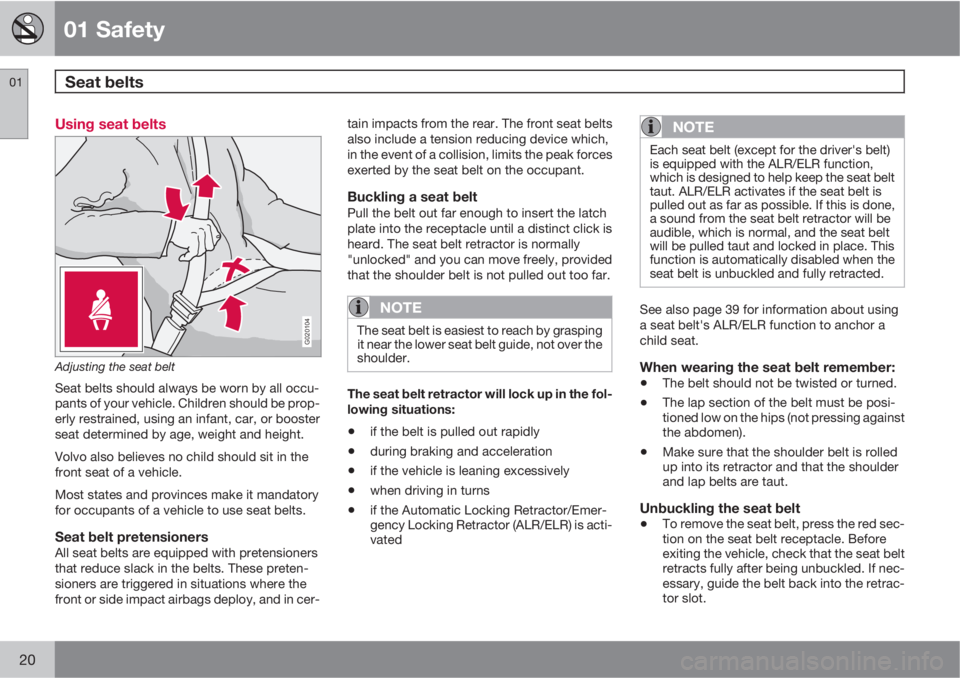
01 Safety
Seat belts 01
20
Using seat belts
G020104
Adjusting the seat belt
Seat belts should always be worn by all occu-
pants of your vehicle. Children should be prop-
erly restrained, using an infant, car, or booster
seat determined by age, weight and height.
Volvo also believes no child should sit in the
front seat of a vehicle.
Most states and provinces make it mandatory
for occupants of a vehicle to use seat belts.
Seat belt pretensionersAll seat belts are equipped with pretensioners
that reduce slack in the belts. These preten-
sioners are triggered in situations where the
front or side impact airbags deploy, and in cer-tain impacts from the rear. The front seat belts
also include a tension reducing device which,
in the event of a collision, limits the peak forces
exerted by the seat belt on the occupant.
Buckling a seat beltPull the belt out far enough to insert the latch
plate into the receptacle until a distinct click is
heard. The seat belt retractor is normally
"unlocked" and you can move freely, provided
that the shoulder belt is not pulled out too far.
NOTE
The seat belt is easiest to reach by grasping
it near the lower seat belt guide, not over the
shoulder.
The seat belt retractor will lock up in the fol-
lowing situations:
•if the belt is pulled out rapidly
•during braking and acceleration
•if the vehicle is leaning excessively
•when driving in turns
•if the Automatic Locking Retractor/Emer-
gency Locking Retractor (ALR/ELR) is acti-
vated
NOTE
Each seat belt (except for the driver's belt)
is equipped with the ALR/ELR function,
which is designed to help keep the seat belt
taut. ALR/ELR activates if the seat belt is
pulled out as far as possible. If this is done,
a sound from the seat belt retractor will be
audible, which is normal, and the seat belt
will be pulled taut and locked in place. This
function is automatically disabled when the
seat belt is unbuckled and fully retracted.
See also page 39 for information about using
a seat belt's ALR/ELR function to anchor a
child seat.
When wearing the seat belt remember:
•The belt should not be twisted or turned.
•The lap section of the belt must be posi-
tioned low on the hips (not pressing against
the abdomen).
•Make sure that the shoulder belt is rolled
up into its retractor and that the shoulder
and lap belts are taut.
Unbuckling the seat belt
•To remove the seat belt, press the red sec-
tion on the seat belt receptacle. Before
exiting the vehicle, check that the seat belt
retracts fully after being unbuckled. If nec-
essary, guide the belt back into the retrac-
tor slot.
Page 28 of 300

01 Safety
Supplemental Restraint System 01
26
WARNING
•Do not use child safety seats or child
booster cushions/backrests in the front
passenger's seat. We also recommend
that occupants under 4 feet 7 inches
(140 cm) in height who have outgrown
these devices sit in the rear seat with the
seat belt fastened
1.
•Never drive with the airbags deployed.
The fact that they hang out can impair
the steering of your vehicle. Other
safety systems can also be damaged.
•The smoke and dust formed when the
airbags are deployed can cause skin
and eye irritation in the event of pro-
longed exposure.
Passenger's side airbag decal
G032934
Airbag decal on the outside of both sun visors
1See also the Occupant Weight Sensor information on page 28.
Page 40 of 300
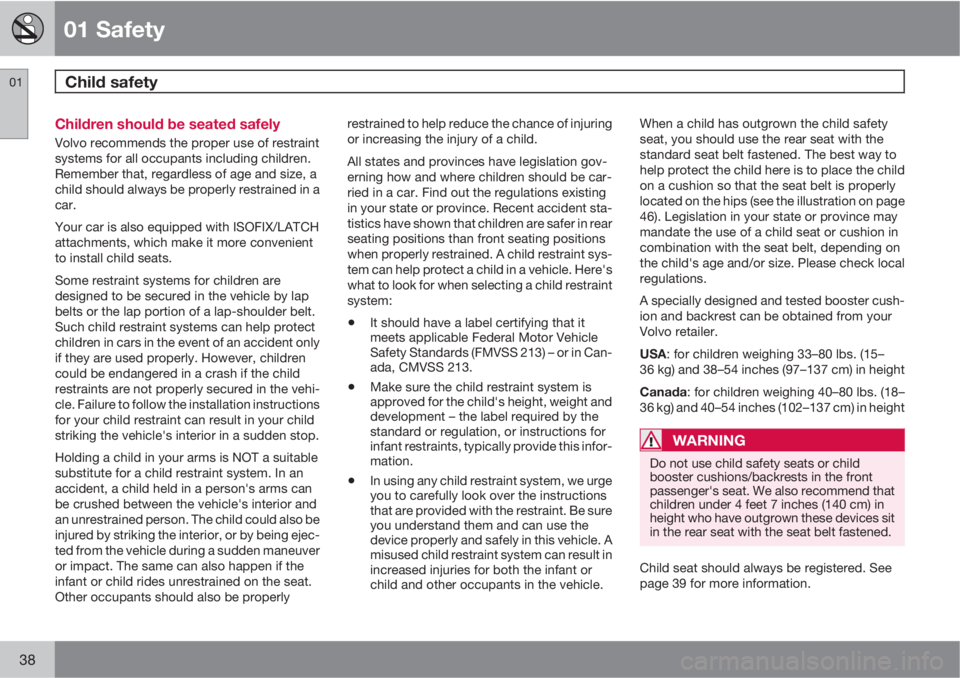
01 Safety
Child safety 01
38
Children should be seated safely
Volvo recommends the proper use of restraint
systems for all occupants including children.
Remember that, regardless of age and size, a
child should always be properly restrained in a
car.
Your car is also equipped with ISOFIX/LATCH
attachments, which make it more convenient
to install child seats.
Some restraint systems for children are
designed to be secured in the vehicle by lap
belts or the lap portion of a lap-shoulder belt.
Such child restraint systems can help protect
children in cars in the event of an accident only
if they are used properly. However, children
could be endangered in a crash if the child
restraints are not properly secured in the vehi-
cle. Failure to follow the installation instructions
for your child restraint can result in your child
striking the vehicle's interior in a sudden stop.
Holding a child in your arms is NOT a suitable
substitute for a child restraint system. In an
accident, a child held in a person's arms can
be crushed between the vehicle's interior and
an unrestrained person. The child could also be
injured by striking the interior, or by being ejec-
ted from the vehicle during a sudden maneuver
or impact. The same can also happen if the
infant or child rides unrestrained on the seat.
Other occupants should also be properlyrestrained to help reduce the chance of injuring
or increasing the injury of a child.
All states and provinces have legislation gov-
erning how and where children should be car-
ried in a car. Find out the regulations existing
in your state or province. Recent accident sta-
tistics have shown that children are safer in rear
seating positions than front seating positions
when properly restrained. A child restraint sys-
tem can help protect a child in a vehicle. Here's
what to look for when selecting a child restraint
system:
•It should have a label certifying that it
meets applicable Federal Motor Vehicle
Safety Standards (FMVSS 213) – or in Can-
ada, CMVSS 213.
•Make sure the child restraint system is
approved for the child's height, weight and
development – the label required by the
standard or regulation, or instructions for
infant restraints, typically provide this infor-
mation.
•In using any child restraint system, we urge
you to carefully look over the instructions
that are provided with the restraint. Be sure
you understand them and can use the
device properly and safely in this vehicle. A
misused child restraint system can result in
increased injuries for both the infant or
child and other occupants in the vehicle.When a child has outgrown the child safety
seat, you should use the rear seat with the
standard seat belt fastened. The best way to
help protect the child here is to place the child
on a cushion so that the seat belt is properly
located on the hips (see the illustration on page
46). Legislation in your state or province may
mandate the use of a child seat or cushion in
combination with the seat belt, depending on
the child's age and/or size. Please check local
regulations.
A specially designed and tested booster cush-
ion and backrest can be obtained from your
Volvo retailer.
USA: for children weighing 33–80 lbs. (15–
36 kg) and 38–54 inches (97–137 cm) in height
Canada: for children weighing 40–80 lbs. (18–
36 kg) and 40–54 inches (102–137 cm) in height
WARNING
Do not use child safety seats or child
booster cushions/backrests in the front
passenger's seat. We also recommend that
children under 4 feet 7 inches (140 cm) in
height who have outgrown these devices sit
in the rear seat with the seat belt fastened.
Child seat should always be registered. See
page 39 for more information.
Page 79 of 300
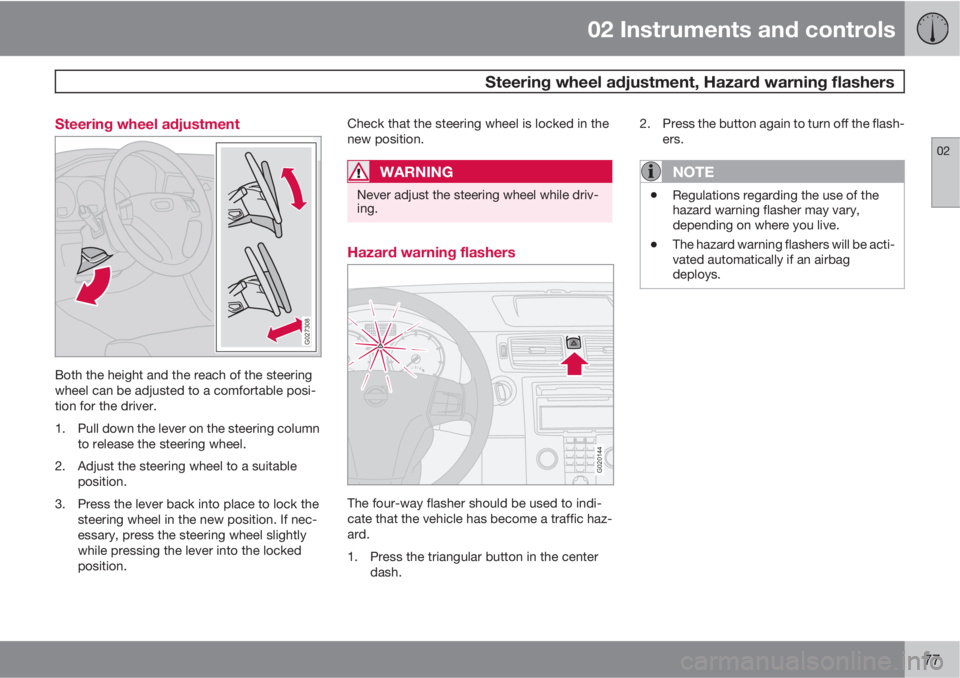
02 Instruments and controls
Steering wheel adjustment, Hazard warning flashers
02
77 Steering wheel adjustment
G027308
Both the height and the reach of the steering
wheel can be adjusted to a comfortable posi-
tion for the driver.
1. Pull down the lever on the steering column
to release the steering wheel.
2. Adjust the steering wheel to a suitable
position.
3. Press the lever back into place to lock the
steering wheel in the new position. If nec-
essary, press the steering wheel slightly
while pressing the lever into the locked
position.Check that the steering wheel is locked in the
new position.
WARNING
Never adjust the steering wheel while driv-
ing.
Hazard warning flashers
G020144
The four-way flasher should be used to indi-
cate that the vehicle has become a traffic haz-
ard.
1. Press the triangular button in the center
dash.2. Press the button again to turn off the flash-
ers.
NOTE
•Regulations regarding the use of the
hazard warning flasher may vary,
depending on where you live.
•The hazard warning flashers will be acti-
vated automatically if an airbag
deploys.
Page 108 of 300
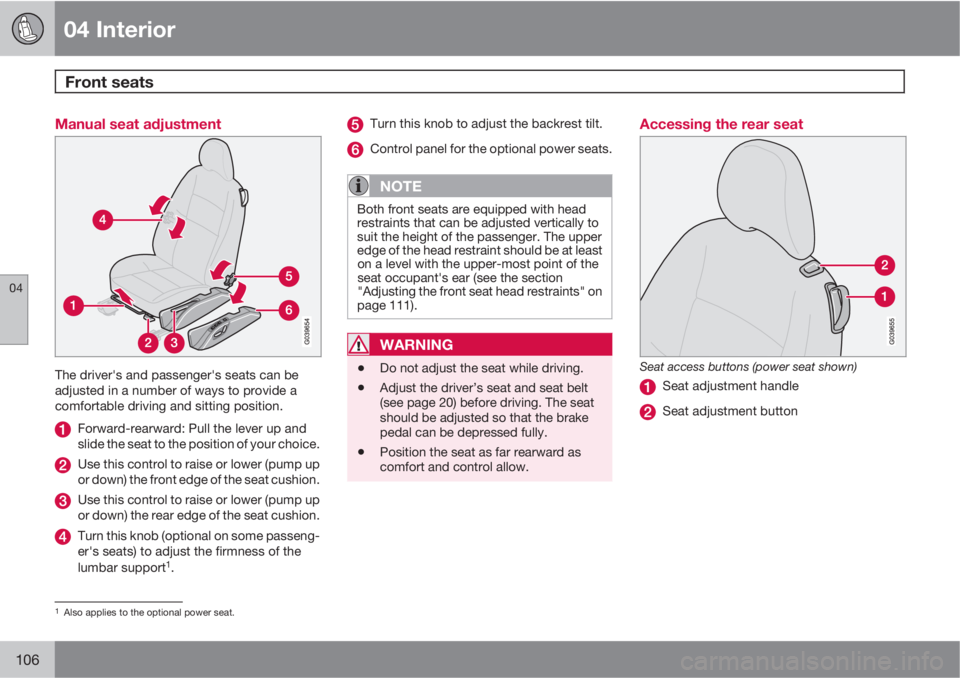
04 Interior
Front seats
04
106
Manual seat adjustment
The driver's and passenger's seats can be
adjusted in a number of ways to provide a
comfortable driving and sitting position.
Forward-rearward: Pull the lever up and
slide the seat to the position of your choice.
Use this control to raise or lower (pump up
or down) the front edge of the seat cushion.
Use this control to raise or lower (pump up
or down) the rear edge of the seat cushion.
Turn this knob (optional on some passeng-
er's seats) to adjust the firmness of the
lumbar support
1.
Turn this knob to adjust the backrest tilt.
Control panel for the optional power seats.
NOTE
Both front seats are equipped with head
restraints that can be adjusted vertically to
suit the height of the passenger. The upper
edge of the head restraint should be at least
on a level with the upper-most point of the
seat occupant's ear (see the section
"Adjusting the front seat head restraints" on
page 111).
WARNING
•Do not adjust the seat while driving.
•Adjust the driver’s seat and seat belt
(see page 20) before driving. The seat
should be adjusted so that the brake
pedal can be depressed fully.
•Position the seat as far rearward as
comfort and control allow.
Accessing the rear seat
Seat access buttons (power seat shown)
Seat adjustment handle
Seat adjustment button
1Also applies to the optional power seat.
Page 112 of 300
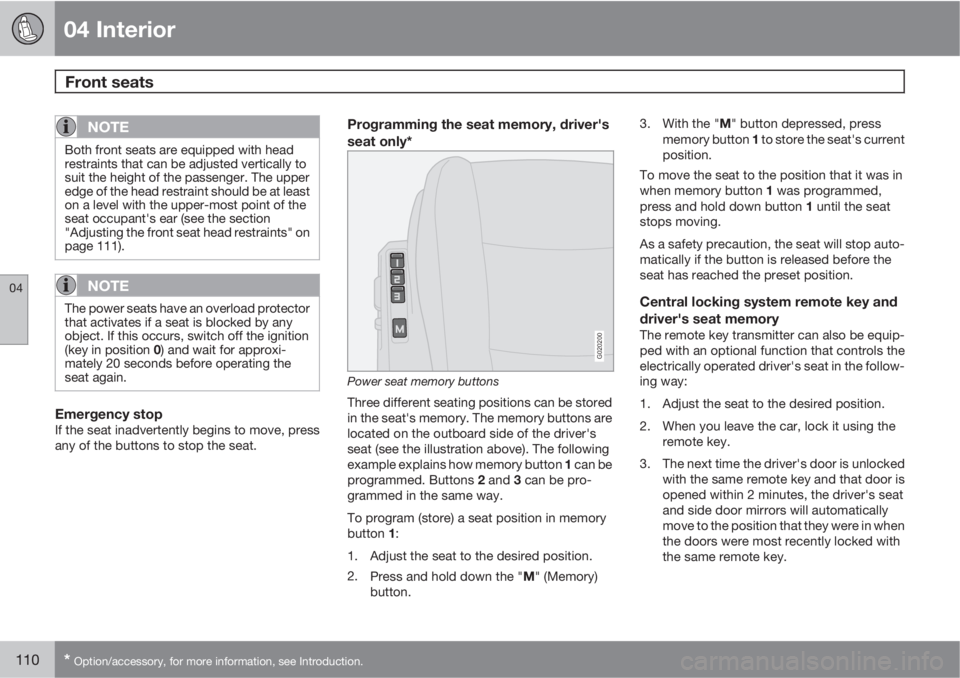
04 Interior
Front seats
04
110* Option/accessory, for more information, see Introduction.
NOTE
Both front seats are equipped with head
restraints that can be adjusted vertically to
suit the height of the passenger. The upper
edge of the head restraint should be at least
on a level with the upper-most point of the
seat occupant's ear (see the section
"Adjusting the front seat head restraints" on
page 111).
NOTE
The power seats have an overload protector
that activates if a seat is blocked by any
object. If this occurs, switch off the ignition
(key in position 0) and wait for approxi-
mately 20 seconds before operating the
seat again.
Emergency stopIf the seat inadvertently begins to move, press
any of the buttons to stop the seat.
Programming the seat memory, driver's
seat only*
G020200
Power seat memory buttons
Three different seating positions can be stored
in the seat's memory. The memory buttons are
located on the outboard side of the driver's
seat (see the illustration above). The following
example explains how memory button 1 can be
programmed. Buttons 2 and 3 can be pro-
grammed in the same way.
To program (store) a seat position in memory
button 1:
1. Adjust the seat to the desired position.
2.
Press and hold down the "M" (Memory)
button.3.
With the "M" button depressed, press
memory button 1 to store the seat's current
position.
To move the seat to the position that it was in
when memory button 1 was programmed,
press and hold down button 1 until the seat
stops moving.
As a safety precaution, the seat will stop auto-
matically if the button is released before the
seat has reached the preset position.
Central locking system remote key and
driver's seat memory
The remote key transmitter can also be equip-
ped with an optional function that controls the
electrically operated driver's seat in the follow-
ing way:
1. Adjust the seat to the desired position.
2. When you leave the car, lock it using the
remote key.
3. The next time the driver's door is unlocked
with the same remote key and that door is
opened within 2 minutes, the driver's seat
and side door mirrors will automatically
move to the position that they were in when
the doors were most recently locked with
the same remote key.
Page 113 of 300
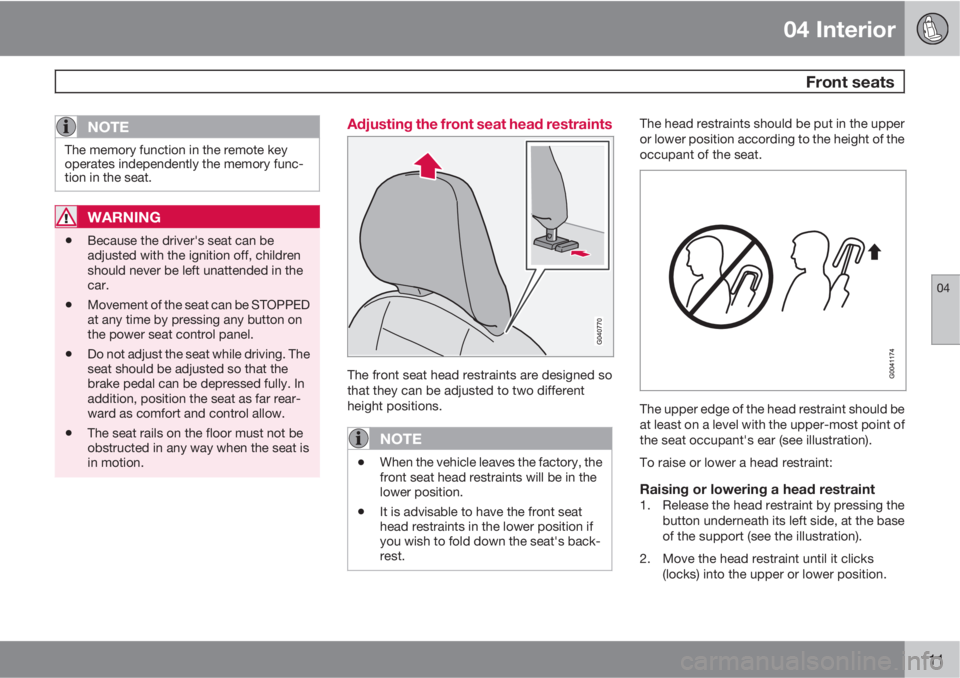
04 Interior
Front seats
04
111
NOTE
The memory function in the remote key
operates independently the memory func-
tion in the seat.
WARNING
•Because the driver's seat can be
adjusted with the ignition off, children
should never be left unattended in the
car.
•Movement of the seat can be STOPPED
at any time by pressing any button on
the power seat control panel.
•Do not adjust the seat while driving. The
seat should be adjusted so that the
brake pedal can be depressed fully. In
addition, position the seat as far rear-
ward as comfort and control allow.
•The seat rails on the floor must not be
obstructed in any way when the seat is
in motion.
Adjusting the front seat head restraints
The front seat head restraints are designed so
that they can be adjusted to two different
height positions.
NOTE
•When the vehicle leaves the factory, the
front seat head restraints will be in the
lower position.
•It is advisable to have the front seat
head restraints in the lower position if
you wish to fold down the seat's back-
rest.
The head restraints should be put in the upper
or lower position according to the height of the
occupant of the seat.
The upper edge of the head restraint should be
at least on a level with the upper-most point of
the seat occupant's ear (see illustration).
To raise or lower a head restraint:
Raising or lowering a head restraint1. Release the head restraint by pressing the
button underneath its left side, at the base
of the support (see the illustration).
2. Move the head restraint until it clicks
(locks) into the upper or lower position.
Page 114 of 300
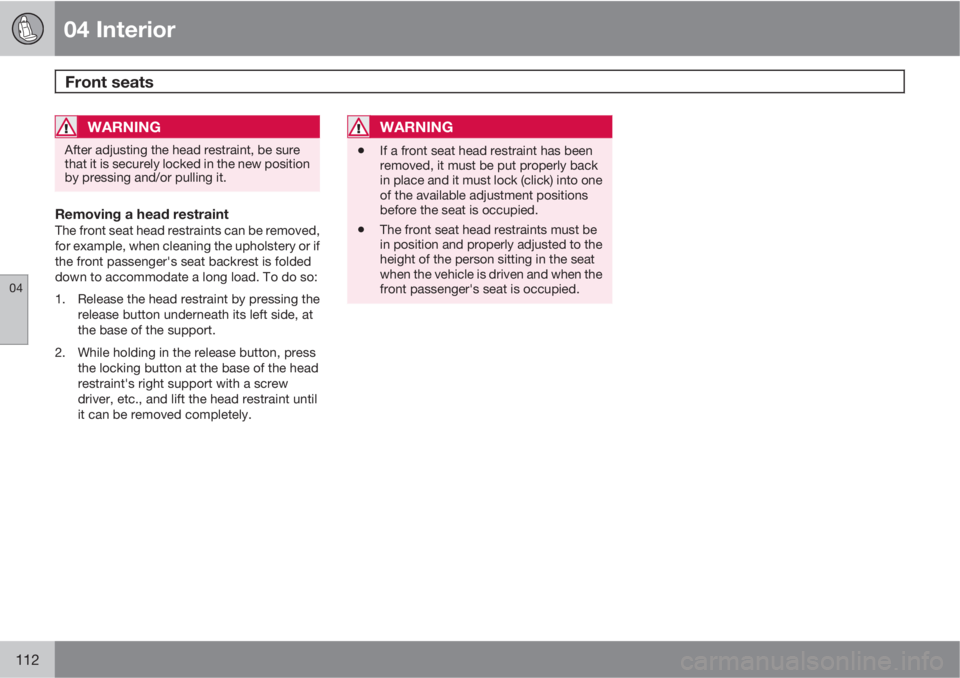
04 Interior
Front seats
04
112
WARNING
After adjusting the head restraint, be sure
that it is securely locked in the new position
by pressing and/or pulling it.
Removing a head restraintThe front seat head restraints can be removed,
for example, when cleaning the upholstery or if
the front passenger's seat backrest is folded
down to accommodate a long load. To do so:
1. Release the head restraint by pressing the
release button underneath its left side, at
the base of the support.
2. While holding in the release button, press
the locking button at the base of the head
restraint's right support with a screw
driver, etc., and lift the head restraint until
it can be removed completely.
WARNING
•If a front seat head restraint has been
removed, it must be put properly back
in place and it must lock (click) into one
of the available adjustment positions
before the seat is occupied.
•The front seat head restraints must be
in position and properly adjusted to the
height of the person sitting in the seat
when the vehicle is driven and when the
front passenger's seat is occupied.
Page 119 of 300
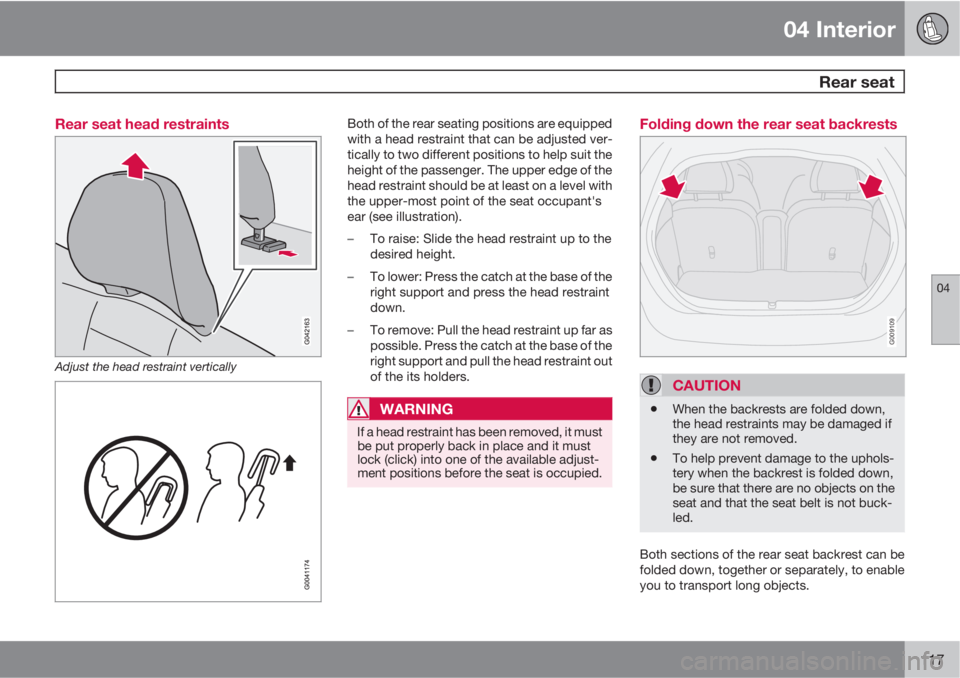
04 Interior
Rear seat
04
117 Rear seat head restraints
Adjust the head restraint vertically
Both of the rear seating positions are equipped
with a head restraint that can be adjusted ver-
tically to two different positions to help suit the
height of the passenger. The upper edge of the
head restraint should be at least on a level with
the upper-most point of the seat occupant's
ear (see illustration).
–To raise: Slide the head restraint up to the
desired height.
–To lower: Press the catch at the base of the
right support and press the head restraint
down.
–To remove: Pull the head restraint up far as
possible. Press the catch at the base of the
right support and pull the head restraint out
of the its holders.
WARNING
If a head restraint has been removed, it must
be put properly back in place and it must
lock (click) into one of the available adjust-
ment positions before the seat is occupied.
Folding down the rear seat backrests
G009109
CAUTION
•When the backrests are folded down,
the head restraints may be damaged if
they are not removed.
•To help prevent damage to the uphols-
tery when the backrest is folded down,
be sure that there are no objects on the
seat and that the seat belt is not buck-
led.
Both sections of the rear seat backrest can be
folded down, together or separately, to enable
you to transport long objects.
Page 180 of 300
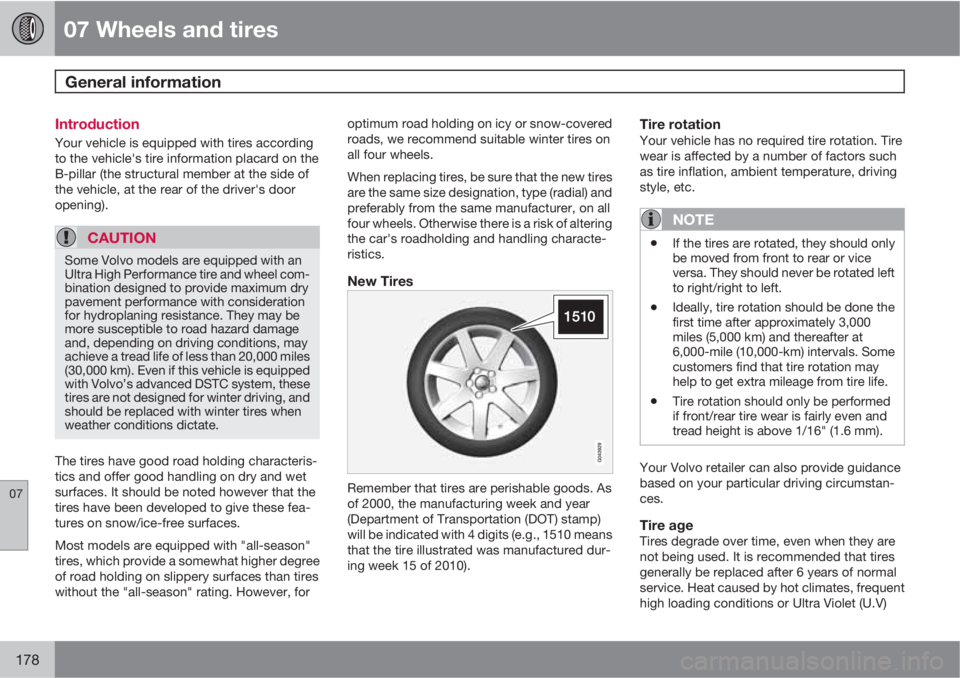
07 Wheels and tires
General information
07
178
Introduction
Your vehicle is equipped with tires according
to the vehicle's tire information placard on the
B-pillar (the structural member at the side of
the vehicle, at the rear of the driver's door
opening).
CAUTION
Some Volvo models are equipped with an
Ultra High Performance tire and wheel com-
bination designed to provide maximum dry
pavement performance with consideration
for hydroplaning resistance. They may be
more susceptible to road hazard damage
and, depending on driving conditions, may
achieve a tread life of less than 20,000 miles
(30,000 km). Even if this vehicle is equipped
with Volvo’s advanced DSTC system, these
tires are not designed for winter driving, and
should be replaced with winter tires when
weather conditions dictate.
The tires have good road holding characteris-
tics and offer good handling on dry and wet
surfaces. It should be noted however that the
tires have been developed to give these fea-
tures on snow/ice-free surfaces.
Most models are equipped with "all-season"
tires, which provide a somewhat higher degree
of road holding on slippery surfaces than tires
without the "all-season" rating. However, foroptimum road holding on icy or snow-covered
roads, we recommend suitable winter tires on
all four wheels.
When replacing tires, be sure that the new tires
are the same size designation, type (radial) and
preferably from the same manufacturer, on all
four wheels. Otherwise there is a risk of altering
the car's roadholding and handling characte-
ristics.
New Tires
Remember that tires are perishable goods. As
of 2000, the manufacturing week and year
(Department of Transportation (DOT) stamp)
will be indicated with 4 digits (e.g., 1510 means
that the tire illustrated was manufactured dur-
ing week 15 of 2010).
Tire rotationYour vehicle has no required tire rotation. Tire
wear is affected by a number of factors such
as tire inflation, ambient temperature, driving
style, etc.
NOTE
•If the tires are rotated, they should only
be moved from front to rear or vice
versa. They should never be rotated left
to right/right to left.
•Ideally, tire rotation should be done the
first time after approximately 3,000
miles (5,000 km) and thereafter at
6,000-mile (10,000-km) intervals. Some
customers find that tire rotation may
help to get extra mileage from tire life.
•Tire rotation should only be performed
if front/rear tire wear is fairly even and
tread height is above 1/16" (1.6 mm).
Your Volvo retailer can also provide guidance
based on your particular driving circumstan-
ces.
Tire ageTires degrade over time, even when they are
not being used. It is recommended that tires
generally be replaced after 6 years of normal
service. Heat caused by hot climates, frequent
high loading conditions or Ultra Violet (U.V)